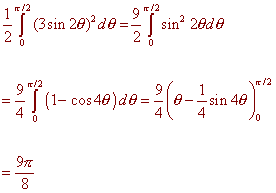Name
MATH 107 PRACTICE
MIDTERM II
Please work out each of the given
problems. Credit will be based on
the steps that you show towards the final answer.
Show your work.
PROBLEM 1 Please answer
the following true or false. If
false, explain why or provide a counter example.
If true explain why.
A. (15 Points) If A, B, and C are points, v is the vector from A to B, w is the vector from B to C, and v x w = 0 , then A, B and C are collinear.
True, since
v x w = ||v|| ||w|| sin q
Hence
sin q = 0
So the angle is 0, thus they are collinear.
B.
(15 Points) If x
= x(t), y = y(t)
are parametric equations of a line then dx/dt
is a constant.
False, consider the line
x = t3, y = t3
For this line
dx/dt = 3t2
which is not a constant.
PROBLEM 2 (21 Points)
Consider the surface x2 + z2 - e2y = 0 . This surface is formed by revolving a generating curve about an axis. Find an equation of this generating curve and state the axis of revolution.
We write
x2 + z2 = e2y = (ey)2
So that the radius is
r(y) = ey
We conclude that the axis of revolution is the y-axis. There are two choices for the generating curve, either
z = ey
or
x = ey (y = lnx)
PROBLEM 3 (21 Points)
Use vectors to find the equation of the line that passes through the point (2,3,4) and is perpendicular to the plane 5x - 4y + 2z = 7.
This line is parallel to the normal vector to the plane. We need to find the equation of the line that passes through the point (2,3,4) and is parallel to the vector <5,-4,2>. The vector equation is
<x,y,z> = <2,3,4> + <5,-4,2>t
The parametric equations are
x = 2 + 5t y = 3 - 4t z = 4 + 2t
PROBLEM 4 (21 Points)
Find all points (if any) of horizontal and vertical tangency. Make sure to present your answer by listing the points not just the values of q.
x = cos q y = 2sin(2q)
We have
dy
dy/dt
4cos(2q)
=
=
dx
dx/dt
-sin q
The horizontal tangent lines occur when the derivative is zero. We set the numerator to zero
4cos(2q) = 0
2q = p/2 + kp
q = p/4 + kp/2
q = p/4 , 3p/4, 5p/4, 7p/4, 9p/4, 11p/4, ...
Plugging these values into the original equation gives
(![]() /2,2)
(-
/2,2)
(-![]() /2,-2)
(-
/2,-2)
(-![]() /2,2)
(
/2,2)
(![]() /2,-2)
/2,-2)
To find the points of vertical tangency, we set the denominator equal to zero
-sin q = 0
q = kp
q = 0, p, 2p, ...
Plugging these values into the original equation gives
(1,0) (-1,0)
PROBLEM 5 (21 Points)
Determine the area of the first quadrant loop of r = 3sin(2q)
The first loop occurs from the first time the radius equals 0 to the second time it equals 0.
0 = 3sin(2q)
q = 0 and q = p/2
Now integrate

PROBLEM 6 (21 Points)
Show that the polar equation for the hyperbola
x2 y2
-
= 1
a2
b2
is
-b2
r2
=
1 - e2 cos2 q
given that
b2
e2
= 1 +
a2
We convert to polar coordinates using
x = r cos q y = r sin q
We have
r2 cos2 q
r2 sin2 q
-
= 1
a2
b2
Now solve for r2
cos2 q
sin2 q
r2 (
-
)
= 1
a2
b2
b2cos2 q - a2
sin2 q
r2 (
)
= 1
a2 b2
a2
b2
-b2
r2
=
=
b2cos2 q - a2
sin2 q
sin2 q - (b2
/ a2)cos2 q
- b2
-b2
=
=
1 - cos2 q - (b2 /
a2)cos2 q
1 - (1 + b2 / a2)cos2 q
-b2
=
1 - e2 cos2 q
PROBLEM 7 (21 Points)
Use vectors to determine if the triangle with vertices (1,0,1), (2,1,0), (0,0,4) is a right triangle.
If a triangle has a right angle, then the cosine of one of the angles equals 0, hence the dot product of two of the displacement vectors is zero. We find displacement vectors by subtracting points.
u = <2 - 1, 1 - 0, 0 - 1> = <2,1,-1>
v = <0 - 1, 0 - 0, 4 - 1> = <-1,0,3>
w = <0 - 2, 0 - 1, 4 - 0> = <-2,-1,4>
Now take the dot products
u . v = -2 + 0 - 3 = -5
u . w = -4 - 1 - 4 = -9
v . w = 2 + 0 + 12 = 14
Since none of the dot products are zero, the triangle is not a right triangle
PROBLEM 8 (21 Points)
Find parametric equations for
the a particle moves along the line through (1,4,2)
and (3,5,7) such that it is at the point (1,4,2)
when t = 0 is at the point
(3,5,7) when t = 2 and is speeding up as
time progresses
If we just wanted a parametric equation of a line we would just use the formula
v + wt
where v is the vector from the origin to (1,4,2) and w is the vector from (1,4,2) to (3,5,7). However, we want to end when t = 2, so we use
v + wt/2
This almost works, but does not speed up as time progresses. We instead use a t2 so that it is speeding up. Since 22 = 4, we use
v + wt2/4
or
<1,4,2> + <2,1,5>t2/4
x = 1 + t2/2 y = 4 + t2/4 z = 2 + 5t2/4